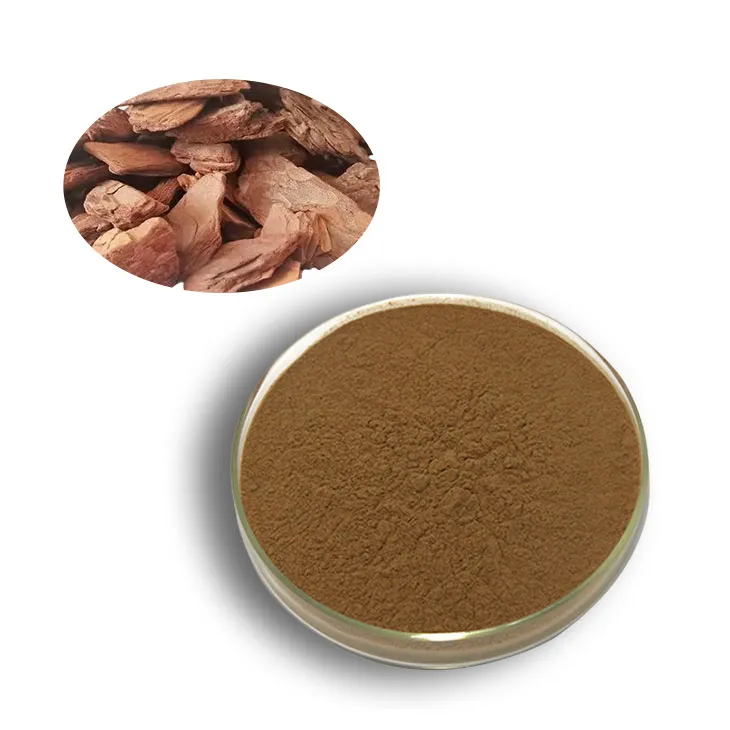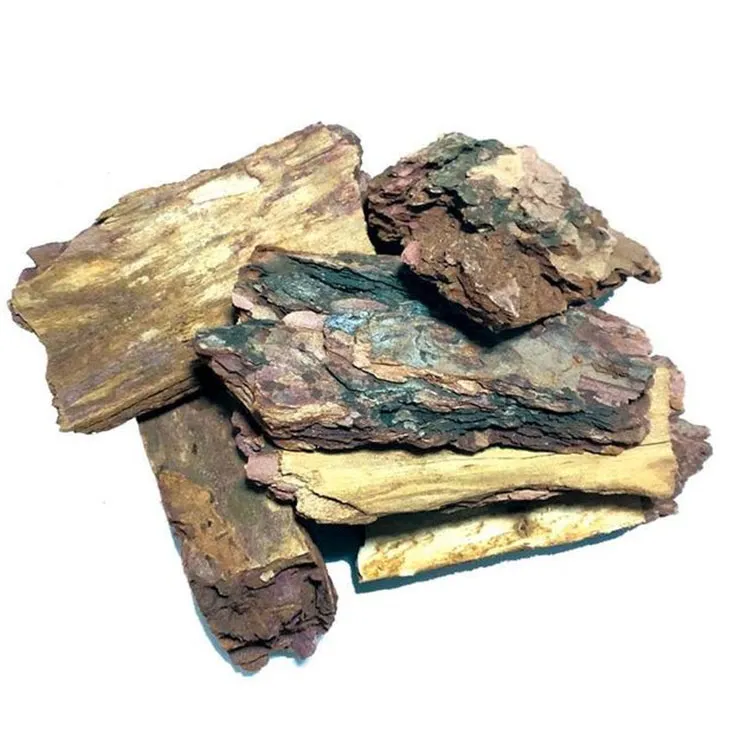- 0086-571-85302990
- sales@greenskybio.com
The best source of natural pine bark extract powder.
2024-11-30

Introduction to Pine bark Extract Powder
Pine bark Extract Powder has gained significant popularity in recent years due to its numerous health benefits. It is rich in proanthocyanidins, which are powerful antioxidants. These antioxidants play a crucial role in protecting the body against oxidative stress, reducing the risk of chronic diseases such as heart disease, cancer, and neurodegenerative disorders.

Environmental Factors Affecting the Quality of Pine Bark Extract
1. Climate
The climate in which pine trees grow has a substantial impact on the quality of the bark extract. In regions with a temperate climate, pine trees tend to grow more slowly. This slow growth can result in a higher concentration of bioactive compounds in the bark. For example, in areas with cold winters and mild summers, the pine trees are forced to adapt to the changing environmental conditions. This adaptation process may lead to an increased production of secondary metabolites, including proanthocyanidins.
2. Soil Quality
The soil type and its nutrient content also influence the quality of pine bark extract. Well - drained, fertile soils are generally more conducive to the growth of healthy pine trees. Soils rich in minerals such as potassium, magnesium, and calcium can enhance the biosynthesis of beneficial compounds in the pine bark. On the other hand, poor - quality soils may result in pine trees that are more susceptible to diseases and pests, which can potentially affect the quality of the bark extract.
3. Altitude
Altitude is another important environmental factor. Pine trees growing at higher altitudes often experience harsher environmental conditions, such as lower oxygen levels, stronger winds, and greater temperature variations. These conditions can stimulate the production of stress - related metabolites in the pine bark. For instance, pine bark from trees grown at higher altitudes may contain a higher proportion of antioxidant compounds compared to those grown at lower altitudes.

Comparison between Wild - grown and Cultivated Pines as Sources
Wild - grown Pines
Advantages
- Wild - grown pines are often exposed to a more natural and diverse range of environmental conditions. This can lead to a more complex chemical composition in the bark extract. For example, they may be subject to natural competition for resources, which can enhance the production of certain bioactive compounds.
- They are generally not exposed to synthetic pesticides or fertilizers, which is appealing to consumers who prefer natural and organic products. This can result in a purer form of Pine bark Extract Powder.
Disadvantages
- Harvesting wild - grown pine bark may pose a threat to the natural ecosystem. Over - harvesting can lead to deforestation and a decline in the population of pine trees, which can have a negative impact on wildlife habitats.
- There may be a lack of standardization in the quality of wild - grown pine bark extract. Since the trees are growing in different natural environments, the concentration of bioactive compounds can vary significantly from one source to another.
Cultivated Pines
Advantages
- Cultivated pines offer a more controlled environment for growth. This allows for better management of factors such as soil quality, irrigation, and pest control. As a result, the quality of the pine bark extract can be more consistent.
- It is easier to ensure sustainable harvesting practices in cultivated pine plantations. Farmers can plan their harvesting schedules in a way that allows the pine trees to regenerate and maintain a healthy population.
Disadvantages
- The use of pesticides and fertilizers in cultivated pine plantations may introduce unwanted chemicals into the pine bark extract. Although modern agricultural practices strive to minimize these residues, there is still a potential risk.
- Cultivated pines may not be exposed to the same level of natural stress as wild - grown pines. This could potentially result in a lower concentration of certain bioactive compounds in the bark extract.

Sustainable Harvesting and its Importance
1. Definition of Sustainable Harvesting
Sustainable harvesting of pine bark refers to the practice of collecting bark in a way that does not deplete the natural resources or harm the environment. It involves careful consideration of factors such as the growth rate of pine trees, the regeneration capacity of the forest, and the impact on other species that depend on the pine ecosystem.
2. Benefits of Sustainable Harvesting
Firstly, sustainable harvesting ensures the long - term availability of pine bark as a source for extract powder. By allowing pine trees to regenerate and grow, we can continue to benefit from the health - promoting properties of pine bark extract for generations to come. Secondly, it helps to maintain the ecological balance of the forest. Pine forests are home to a wide variety of wildlife, and sustainable harvesting practices protect their habitats.
3. Strategies for Sustainable Harvesting
One strategy is to implement rotational harvesting. This involves dividing the pine forest into different sections and harvesting bark from one section at a time, allowing the other sections to recover. Another strategy is to set limits on the amount of bark that can be harvested from each tree. This ensures that the tree can still function properly and continue to grow. Additionally, promoting the growth of young pine trees through proper forest management practices can also contribute to sustainable harvesting.
Conclusion
Finding the best source of natural pine bark extract powder is a complex task that involves considering multiple factors. Environmental factors such as climate, soil quality, and altitude play a significant role in determining the quality of the extract. While wild - grown pines offer certain advantages in terms of a more natural chemical composition, they also come with challenges related to sustainability and quality control. Cultivated pines, on the other hand, provide a more controlled environment but may have potential issues with chemical residues and lower bioactive compound concentrations. Sustainable harvesting is crucial regardless of the source, as it ensures the long - term availability of pine bark extract powder and the protection of the environment. By carefully weighing these factors, we can make informed decisions about the best source of natural pine bark extract powder.
FAQ:
What are the main environmental factors affecting the quality of pine bark extract powder?
Several environmental factors can impact the quality of pine bark extract powder. Soil quality plays a crucial role. Fertile and well - drained soil can provide better nutrients for pine trees, which may influence the composition and quality of the bark extract. Climate conditions are also important. Adequate sunlight, temperature, and rainfall can affect the growth and development of pine trees. For example, a region with stable and suitable climate may result in pine trees with healthier bark that contains more beneficial compounds. Additionally, altitude and air quality can have an impact. Higher altitude areas might expose pine trees to different environmental stresses, potentially leading to the production of unique compounds in the bark. Clean air, free from pollutants, is more likely to support the growth of healthy pine trees, which in turn can affect the quality of the extract.
What are the differences between wild - grown and cultivated pine sources for pine bark extract powder?
Wild - grown pines and cultivated pines have several differences as sources for pine bark extract powder. Wild - grown pines are exposed to natural and often more diverse environmental conditions. They may grow at different altitudes, soil types, and with less human interference. This can lead to a wider variation in the chemical composition of their bark. The extract from wild - grown pines might contain unique compounds due to these natural variations. On the other hand, cultivated pines are grown under more controlled conditions. This allows for better management of factors like soil nutrition, pest control, and watering. Cultivated pines may have a more consistent quality in terms of the bark extract, as the growth conditions can be optimized for a specific desired composition. However, they may lack some of the unique compounds that wild - grown pines might possess due to their more natural and diverse growth environments.
How is sustainable harvesting important for obtaining high - quality pine bark extract powder?
Sustainable harvesting is crucial for obtaining high - quality pine bark extract powder. Firstly, it ensures the long - term availability of pine trees as a source. If harvesting is not sustainable, it can lead to over - exploitation, which may deplete the pine tree population. This not only affects the future supply of the extract but also disrupts the ecosystem where the pines are located. Sustainable harvesting practices also promote the health of the remaining pine trees. For example, proper harvesting techniques, such as not removing too much bark from a single tree, allow the tree to continue to grow and function properly. This is important because a healthy tree is more likely to produce high - quality bark with a rich composition of beneficial compounds. Additionally, sustainable harvesting can have positive environmental impacts, such as maintaining soil stability and providing habitats for other organisms, which ultimately contribute to the overall quality of the pine bark extract powder.
What are the benefits of using natural pine bark extract powder?
Natural pine bark extract powder offers several benefits. It is rich in bioactive compounds such as proanthocyanidins. These compounds have antioxidant properties, which can help in neutralizing free radicals in the body. This may contribute to reducing oxidative stress, which is associated with various health problems like aging, cardiovascular diseases, and certain cancers. Pine bark extract powder may also have anti - inflammatory effects. It can potentially help in alleviating inflammation in the body, which is beneficial for conditions such as arthritis. Additionally, it has been studied for its potential to improve blood circulation by enhancing the function of blood vessels. This could have positive impacts on overall cardiovascular health.
How can one ensure the purity of pine bark extract powder?
To ensure the purity of pine bark extract powder, several steps can be taken. Firstly, sourcing from reliable suppliers is crucial. Reputable suppliers are more likely to follow strict quality control measures during the extraction process. They should be able to provide information about the origin of the pine bark, the extraction methods used, and any quality certifications. Laboratory testing is also important. This can include tests for the presence of contaminants such as heavy metals, pesticides, and other impurities. High - performance liquid chromatography (HPLC) can be used to analyze the chemical composition of the extract powder and ensure that it contains the expected bioactive compounds in the correct proportions. Additionally, proper storage conditions are necessary to maintain the purity of the powder. It should be stored in a cool, dry place away from sunlight and sources of contamination.
Related literature
- The Quality and Bioactivity of Pine Bark Extract: A Review"
- "Environmental Influences on Pine Bark Composition for Extract Production"
- "Sustainable Harvesting of Pine Bark: Best Practices"
- "Comparative Analysis of Wild - grown and Cultivated Pine Bark Extracts"
- ▶ Hesperidin
- ▶ citrus bioflavonoids
- ▶ plant extract
- ▶ lycopene
- ▶ Diosmin
- ▶ Grape seed extract
- ▶ Sea buckthorn Juice Powder
- ▶ Beetroot powder
- ▶ Hops Extract
- ▶ Artichoke Extract
- ▶ Reishi mushroom extract
- ▶ Astaxanthin
- ▶ Green Tea Extract
- ▶ Curcumin Extract
- ▶ Horse Chestnut Extract
- ▶ Other Problems
- ▶ Boswellia Serrata Extract
- ▶ Resveratrol Extract
- ▶ Marigold Extract
- ▶ Grape Leaf Extract
- ▶ blog3
- ▶ Aminolevulinic acid
- ▶ Cranberry Extract
- ▶ Red Yeast Rice
- ▶ Red Wine Extract
-
Stevia Extract
2024-11-30
-
Dandelion Root Extract
2024-11-30
-
Lotus leaf extract
2024-11-30
-
Yam Extract
2024-11-30
-
Fig Extract
2024-11-30
-
Alisma Extract
2024-11-30
-
Sea buckthorn oil
2024-11-30
-
Green Tea Extract
2024-11-30
-
Coix Seed Extract
2024-11-30
-
Carrageenan Extract Powder
2024-11-30





















